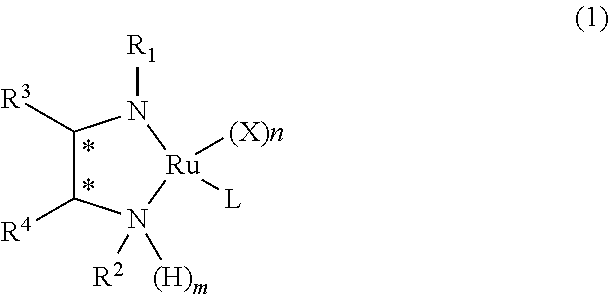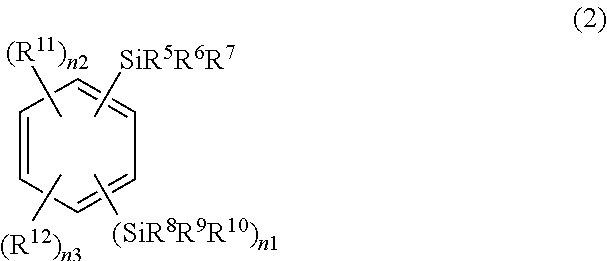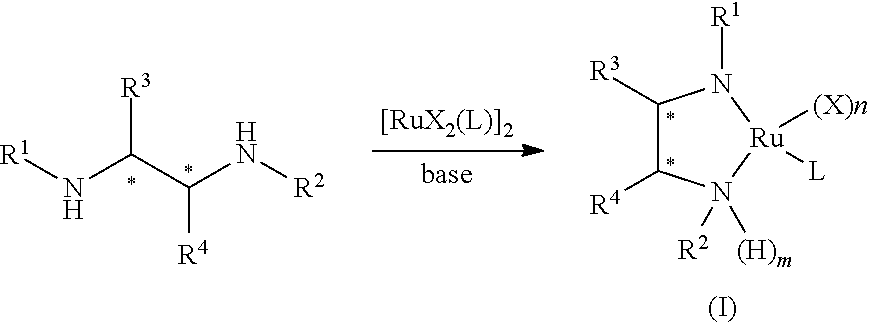Ruthenium-diamine complex and methods for producing optically active compounds
a technology of ruthenium diamine and complex, which is applied in the direction of organic compound/hydride/coordination complex catalyst, organic compound/chemical process catalyst, ruthenium organic compound, etc., can solve the problems of unsatisfactory catalyst activity and asymmetric yield, and achieve excellent steric selectivity, high asymmetric yield, and strong catalytic activity
- Summary
- Abstract
- Description
- Claims
- Application Information
AI Technical Summary
Benefits of technology
Problems solved by technology
Method used
Image
Examples
example 1
Synthesis of RuCl{(R,R)-Msdpen}(TMS-toluene)
[0061]
[0062]In a 50-ml Schlenck tube, 0.385 g (0.574 mmol) of [RuCl2(TMS-toluene)]2, 0.333 g (1.15 mmol) of (R,R)-Msdpen, and 0.32 ml (2.3 mmol) of triethylamine were dissolved in 10 ml of isopropanol, and the solution was stirred for 1.5 hours at 80° C. Subsequently, isopropanol was evaporated under reduced pressure until the volume of isopropanol reached approximately a half the original volume. 20 ml of distilled water was added thereto, and crystals precipitated therefrom were filtered. The filter cake was washed with water. The obtained crystals were dried under reduced pressure at 60° C. for 5 hours, and thereby 0.60 g of the desired complex, RuCl[(R,R)-Msdpen] (TMS-toluene) was obtained at a yield of 89%.
[0063]1H-NMR (CDCl3, 300 MHz) δ:
[0064]0.45 (s, 9H, —Si(CH3)3),
[0065]2.37 (s, 3H, CH3—C6H4—Si(CH3)3).
[0066]2.47 (s, 3H, —SO2—CH3), 3.72 (m, 1H, NHH), 3.72 (m, 1H, HCNMs),
[0067]3.90 (m, 1H, HCNH2), 5.10 (m, 1H, NHH),
[0068]5.36, 5.44, ...
example 2
Synthesis of RuCl[(R,R)-Tsdpen](TMS-toluene)
[0070]
[0071]In a 50-ml Schlenk tube, 0.46 g (0.682 mmol) of [RuCl2(TMS-toluene)]2, 0.5 g (1.36 mmol) of (R,R)-Tsdpen, and 0.38 ml (2.7 mmol) of triethylamine were dissolved in 13 ml of isopropanol, and the solution was stirred for one hour at 80° C. Subsequently, isopropanol was evaporated under reduced pressure until the volume of isopropanol reached approximately a half the original volume. 25 ml of distilled water was added thereto, and crystals precipitated therefrom were filtered. The filter cake was washed with water. The obtained crystals were dried under reduced pressure at 60° C. for 5 hours, and thereby 0.82 g of the desired complex, RuCl[(R,R)-Tsdpen] (TMS-toluene) was obtained at a yield of 90%.
[0072]1H-NMR (CD2Cl2, 300 MHz) δ:
[0073]0.47 (s, 9H, Si(CH3)3), 2.26 (s, 3H, —SiC6H4—CH3),
[0074]2.42 (s, 3H, —SO2C6H4—CH3), 3.67 (m, 1H, NHH),
[0075]3.67 (m, 1H, HCNH2), 3.85 (m, 1H, HCN-pTs), 5.05 (m, 1H, NHH),
[0076]5.48, 5.58, 5.67, 5.79...
example 3
Hydrogen Transfer Type Reaction of 1-acetylnaphthalene
[0078]In a 20-ml Schlenk tube, 28 mg (0.05 mmol) of RuCl[(R,R)-Msdpen] (TMS-toluene) (S / C=100), 0.85 g (5.0 mmol) of 1-acetylnaphthalene, and 2.5 ml of a formic acid-triethylamine (5:2) azeotropic mixture were mixed, and the tube was purged with nitrogen. The mixture was allowed to react for 48 hours at 30° C. The yield and optical purity were measured by GC analysis, and as a result, optically active 1-naphthylethanol, which was the target reduction product, was obtained at a conversion rate of 83.6% and an optical purity of 96.2% ee.
PUM
| Property | Measurement | Unit |
|---|---|---|
| temperature | aaaaa | aaaaa |
| temperature | aaaaa | aaaaa |
| pressure | aaaaa | aaaaa |
Abstract
Description
Claims
Application Information
 Login to View More
Login to View More - R&D
- Intellectual Property
- Life Sciences
- Materials
- Tech Scout
- Unparalleled Data Quality
- Higher Quality Content
- 60% Fewer Hallucinations
Browse by: Latest US Patents, China's latest patents, Technical Efficacy Thesaurus, Application Domain, Technology Topic, Popular Technical Reports.
© 2025 PatSnap. All rights reserved.Legal|Privacy policy|Modern Slavery Act Transparency Statement|Sitemap|About US| Contact US: help@patsnap.com



